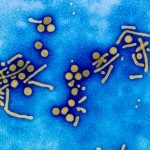Lien vers Pubmed [PMID] – 23818075
Environ Sci Pollut Res Int 2014 Apr;21(7):4940-9
Pesticides are frequently detected in estuaries among the pollutants found in estuarine and coastal areas and may have major ecological consequences. They could endanger organism growth, reproduction, or survival. In the context of high-mortality outbreaks affecting Pacific oysters, Crassostrea gigas, in France since 2008, it appears of importance to determine the putative effects of pesticides on oyster susceptibility to infectious agents. Massive mortality outbreaks reported in this species, mainly in spring and summer, may suggest an important role played by the seasonal use of pesticides and freshwater input in estuarine areas where oyster farms are frequently located. To understand the impact of some pesticides detected in French waters, their effects on Pacific oyster hemocytes were studied through short-term in vitro experiments. Bivalve immunity is mainly supported by hemocytes eliminating pathogens by phagocytosis and producing compounds including lysosomal enzymes and antimicrobial molecules. In this study, oyster hemocytes were incubated with a mixture of 14 pesticides and metaldehyde alone, a molecule used to eliminate land mollusks. Hemocyte parameters including dead/alive cells, nonspecific esterase activities, intracytoplasmic calcium, lysosome number and activity, and phagocytosis were monitored by flow cytometry. No significant effect of pesticides tested at different concentrations was reported on oyster hemocytes maintained in vitro for short-term periods in the present study. It could be assumed that these oyster cells were resistant to pesticide exposure in tested conditions and developing in vivo assays appears as necessary to better understand the effects of pollutants on immune system in mollusks.

